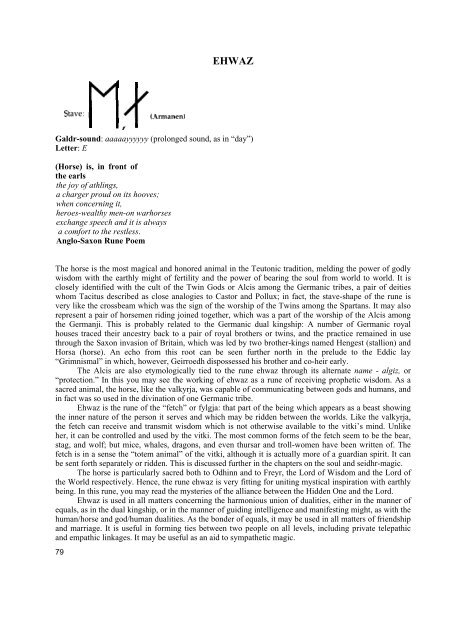TEUTONIC MAGIC - Awaken Video
TEUTONIC MAGIC - Awaken Video
TEUTONIC MAGIC - Awaken Video
Create successful ePaper yourself
Turn your PDF publications into a flip-book with our unique Google optimized e-Paper software.
EHWAZ<br />
Galdr-sound: aaaaayyyyyy (prolonged sound, as in “day”)<br />
Letter: E<br />
(Horse) is, in front of<br />
the earls<br />
the joy of athlings,<br />
a charger proud on its hooves;<br />
when concerning it,<br />
heroes-wealthy men-on warhorses<br />
exchange speech and it is always<br />
a comfort to the restless.<br />
Anglo-Saxon Rune Poem<br />
The horse is the most magical and honored animal in the Teutonic tradition, melding the power of godly<br />
wisdom with the earthly might of fertility and the power of bearing the soul from world to world. It is<br />
closely identified with the cult of the Twin Gods or Alcis among the Germanic tribes, a pair of deities<br />
whom Tacitus described as close analogies to Castor and Pollux; in fact, the stave-shape of the rune is<br />
very like the crossbeam which was the sign of the worship of the Twins among the Spartans. It may also<br />
represent a pair of horsemen riding joined together, which was a part of the worship of the Alcis among<br />
the Germanji. This is probably related to the Germanic dual kingship: A number of Germanic royal<br />
houses traced their ancestry back to a pair of royal brothers or twins, and the practice remained in use<br />
through the Saxon invasion of Britain, which was led by two brother-kings named Hengest (stallion) and<br />
Horsa (horse). An echo from this root can be seen further north in the prelude to the Eddic lay<br />
“Grimnismal” in which, however, Geirroedh dispossessed his brother and co-heir early.<br />
The Alcis are also etymologically tied to the rune ehwaz through its alternate name - algiz, or<br />
“protection.” In this you may see the working of ehwaz as a rune of receiving prophetic wisdom. As a<br />
sacred animal, the horse, like the valkyrja, was capable of communicating between gods and humans, and<br />
in fact was so used in the divination of one Germanic tribe.<br />
Ehwaz is the rune of the “fetch” or fylgja: that part of the being which appears as a beast showing<br />
the inner nature of the person it serves and which may be ridden between the worlds. Like the valkyrja,<br />
the fetch can receive and transmit wisdom which is not otherwise available to the vitki’s mind. Unlike<br />
her, it can be controlled and used by the vitki. The most common forms of the fetch seem to be the bear,<br />
stag, and wolf; but mice, whales, dragons, and even thursar and troll-women have been written of. The<br />
fetch is in a sense the “totem animal” of the vitki, although it is actually more of a guardian spirit. It can<br />
be sent forth separately or ridden. This is discussed further in the chapters on the soul and seidhr-magic.<br />
The horse is particularly sacred both to Odhinn and to Freyr, the Lord of Wisdom and the Lord of<br />
the World respectively. Hence, the rune ehwaz is very fitting for uniting mystical inspiration with earthly<br />
being. In this rune, you may read the mysteries of the alliance between the Hidden One and the Lord.<br />
Ehwaz is used in all matters concerning the harmonious union of dualities, either in the manner of<br />
equals, as in the dual kingship, or in the manner of guiding intelligence and manifesting might, as with the<br />
human/horse and god/human dualities. As the bonder of equals, it may be used in all matters of friendship<br />
and marriage. It is useful in forming ties between two people on all levels, including private telepathic<br />
and empathic linkages. It may be useful as an aid to sympathetic magic.<br />
79
















